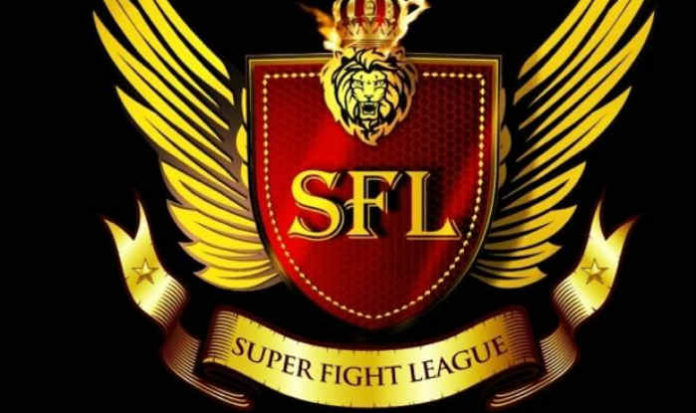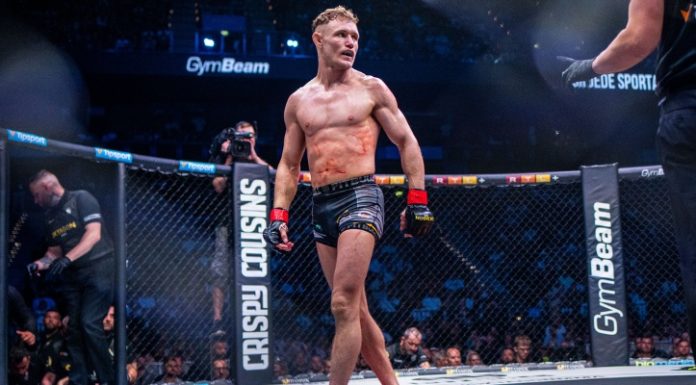
Part three of our dive into the history of Indian MMA will focus on the premier organization in the country, Super Fight League.
In the last part, we learned how money and mismanagement were two of the biggest problems which stood in the way of the Indian MMA community’s growth. Without finances and regulation, the entire infrastructure couldn’t be upgraded, fighters couldn’t go out to train and develop their skills, fighter safety was overlooked, and the Indian MMA community found it difficult to gain recognition overseas.
In this part, we will be focusing on the development of the business side of the Indian MMA structure.
Creation of SFL
The development of Indian MMA in terms of the business it generated has always pivoted around one promotion: Super Fight League, popularly known as SFL.
SFL is synonymous with Indian MMA as it is the only major Indian MMA promotion and was founded by British businessman Raj Kundra and Bollywood star Sanjay Dutt. The aim was to create a promotion like the UFC but with a touch of Indian “desi-ness.”
Raj Kundra
Raj Kundra was a British businessman and an MMA fan who wanted to start his own MMA promotion in India. In an interview with Boxing Insider, he said:
“I am a huge MMA fan and knowing it’s the fastest growing sport in the world, I would hate to see India get left behind. Through our professional resources and skills, we plan to train and create super fighters out of India. The beauty of MMA is it’s not fixed or staged. The results are unpredictable, and the fighters require more skills than any other combat sport in the world. It gives me great pleasure along with my partner Sanjay Dutt to introduce you to The Super Fight League.”
The statement makes it amply clear that Kundra was keen on investing in upgrading Indian MMA and was going to target both Indian and international audience at the same time. How it went is a topic that we will cover later in our story, but for now, let us focus on the flow of events. Please keep in mind that all of this was happening around the year 2011. By this time, Gym Wars, FCC and many minor gyms come into the picture, and there was no single superpower in Indian MMA.
Association with Daniel Isaac
The most important event in early Indian MMA days was Raj Kundra aligning himself with Gym Wars owner Daniel Isaac. There are no official documents available in public domain about how Kundra and Daniel formed an alliance, but it is rumored that Kundra did a survey on the MMA scene in India. FCC owner Prashant Kumar claims that Raj Kundra contacted him.
“Raj Kundra did contact us and even asked us to join Super Fight League. However, we had a few ideological differences; hence, we didn’t join hands,” Kumar said.
Per Isaac, Kundra contacted him one day via email. “On Saturday, December 10, 2011, at 12:48 AM, I received an email from Raj Kundra saying, ‘I am launching MMA in a big way in India, would like to meet and discuss synergies.’ Raj and I met in Mumbai, he invited me to join the Super Fight League as one of the board members and asked me to take the position of COO of SFL. In 2013, he asked me to take the position of CEO of SFL once Ken Pavia resigned. The rest is history.”
This association was sealed with the appointment of Isaac as the COO of Super Fight League.
Consequences
It brought AIMMA to power
AIMMA was the sanctioning body of Gym Wars created by Daniel Isaac and Alan Fenandes. As stated in the previous write-ups, MMA was not a governmentally-recognized sport; hence, anyone could start an organization and call it the official sanctioning body. However, AIMMA came to prominence because of its association with the sole popular Indian MMA organization, SFL.
A detailed study of the body will be done in the next write up.
It put an end to Gym Wars
Daniel closed down his promotion Gym Wars after signing on as the COO of SFL. This was an important moment in Indian MMA history as Gym Wars was the first Indian MMA promotion. The closing down of Gym Wars also led to all Gym Wars fighters joining SFL.
It brought about temporary unity
Daniel Isaac assuming the role of the COO meant that all the SFL funds more or less came under his control. This access to money allowed him to overpower his rivals and unite the Indian MMA community.
However, this phase of unity was not led by understanding. In fact, it was led by the clout of money. After some time, the community was more forcefully glued rather than organically united.
2012 in SFL
As stated above, SFL was launched with the vision of creating a promotion like the UFC with a touch of Indian culture. SFL was also the first ever mainstream professional combat sports promotion of India. This means the organizers literally had no idea what the reaction of the Indian market would be like. Each event would roughly have around eight fights and most fight cards saw the main event between non-Indian fighters. Each card would have some or the other form of performance, followed by a lot of additional hype around fights and a good deal of investment in entertainment channels.
One could clearly see from the entire set-up of the season that SFL was trying to add the dramatic flair of Bollywood to the sport of MMA. They were trying to sell it as a mixture of pro wrestling and MMA, a move many promotions in the past had tried and met with success. The gimmick was also a safe bet as a large majority of the Indian population had always loved Bollywood-ish drama
Fighters
The 2012 season of SFL saw both Indian and foreign fighters compete in the season. The majority of the fighters competing in the tournament were FCC and Gym Wars vets, while most of the foreign fighters were either very new to the world of pro-MMA or were coming down to SFL to face a step down in competition.
The majority of today’s famous Indian MMA fighters have in the past competed in SFL. Most of these fighters were either trained in the SFL gyms or were a part of the Gym Wars-FCC era, and hence, knew how to compete in MMA, but not too well. The Gym Wars and FCC fighters too hadn’t really competed in documented MMA matches, so they were clearly not up to MMA standards. This was the reason most Indian MMA fighters were not ready for the glamorous push SFL was offering them.
Even in terms of international fighters, SFL didn’t really bring in the best. They brought in Bob Sapp to main event their first event.
Now, who was Bob Sapp? Bob Sapp was one of the scariest MMA fighters back in the PRIDE days. However, he soon realized that he could earn more money if he fixed matches in new promotions and embarrassed himself in the ring. Sapp was a man known for fixing his matches, and guess what happened when he entered the SFL cage for their first event? He lost and tapped out to a takedown.
Yes, you read that right… a takedown! The rest of the fighters brought in were never really in the league of the excellent. The majority of them, like Colleen Schneider, were on a losing streak and were simply looking for a step down in competition.
In fact, in the year 2012, SFL only brought in one quality MMA fighter, Joanne Calderwood.
Reception
The first event of SFL received a ton of attention. Close to 300,000 people watched it live on YouTube. However, the event failed to continue its mass appeal and failed to maintain the viewership. The very next event, the number of viewers fell to less than 3,000. In fact, almost for the entire year, the viewership continued to be in this range.
The fall in viewers wasn’t limited to the internet. There was a drastic drop even in the number of people attending the events. SFL, in the first event, saw an amazingly large gathering of audience in attendance.
The sharp fall in ratings and attendance made it very clear that people only visited the first event because of its grand set-up.
The first event of SFL was attended by many top Bollywood stars, the entire concept of MMA was presented as a super-cool American sport being brought to India and how it will revolutionize the entire Indian sporting structure.
The hype even managed to get MMA fans across the globe excited. However, the first event failed brutally and had the impact of a wet blanket on the audience’s enthusiasm. The fights were horrible, which lead to excessive criticism from various international media outlets. Responding to the statements, former SFL COO, Daniel Isaac comments, “The 2012 seasons of Super Fight League was the beginning of mainstream MMA in India. I was part of the entire operation and event planning on each show. SFL pumped huge amounts of money into SFL 1, 2, and 3,” said Isaac. “The CEO and matchmaker was Ken Pavia from the US. Ken had a history of clashes with the UFC and SFL didn’t realize that by having Pavia on-board SFL as CEO we were not only challenging the biggest entity in the sport [the UFC], but we were taking on his bad blood with them. The rest again is history. I have nothing to say about the criticism that the 2012 season of SFL received except I feel it is all part and parcel of a new sport. The 2012 SFL TV show Challengers brought fighters who were unheard of onto mainstream Indian television.”
This criticism resulted in many international fans losing interest in SFL. The event which was planned to be the glorious start of a new era saw an early crash.
SFL Challengers
SFL Challengers was a reality TV show similar to The Ultimate Fighter. Eight male and eight female upcoming Indian MMA fighters were picked, kept in the same house and were set to compete for, “Rs. 20 lakhs (approx. $30,000 / £22,000) and a three-year contract worth Rs. 25 lakhs.”
The winners of the reality TV show were Manjit Kolekar and Kario Isaac.
However, Manjit Kolekar recently went on record to say that she had in the past not been paid by SFL. She stated:
“All started way back in SFL Challengers—the reality show that I won. The winner of the show was promised Rs. 25 lakhs. But when I won the show, I didn’t get a single rupee. I asked for the money time and again, but they refused to answer my phones or emails. I went to their office every day and fought. At last, they paid me Rs. 5 lakhs. That, by the way, is 1/5th of what they promised. They have very proudly written that they have paid me this or that amount, but the reality of SFL is that they cheated not only me but also several others. They, in fact, were the ones who tried to break me mentally. They wouldn’t answer my phone, kept me on tenterhooks and refused to let me fight outside of SFL for over a year, and apart from that they didn’t even give me a single fight. I would literally beg for fights, but my calls would go unanswered. It may sound rude, but my experience with SFL has been one of the most horrible experiences of my life.”
Whether or not Kario Isaac was paid is something which we cannot confirm. However, many sources have stated that Isaac too wasn’t paid what he was promised.
However, Daniel Isaac denied all these claims. He stated that the fighters were given what their contract stated. He said, “All fighters signed to SFL were explained all the terms and conditions of their contracts, they signed their contracts after understanding details of their paperwork,” Isaac continued, “As long as they were being featured on LIVE tv across India and Asia, as long as they were winning their fights, as long as they were in good books with the SFL they had nothing bad to say. The moment they breached contract terms and walked out on the SFL they started going to the press and media to try and protect themselves. Unknown people who had issues with the SFL management joined in with these fighters and backed up their claims by getting them out into the media. Manjit is a very talented fighter but she unfortunately had some clashes with the SFL and its management due to some contract disputes. I only have good things to say about Manjit and her talent as a fighter.”
Flaws in approach to the sport
Targeting both Indian and international audience at the same time
SFL made a mistake that many promoters in the past had. MMA as a sport was a very new concept. The Indian audience did not know what the sport of MMA was all about, so they had to be introduced to the entire concept. Hence, creating the drama and adding the flair of Bollywood was necessary to attract viewers. However, the majority of the international audience didn’t care about which Indian star was attending the event. So when the cameras constantly shifted between the ongoing match and the Bollywood stars, most overseas hardcore MMA fans found it irritating and eventually lost interest in the promotion.
Making Bollywood the centerpiece of the promotion
Yes, Bollywood plays an important role in getting things mainstream attention in India, but that cannot be the main attraction of a sporting event. Bollywood cannot be the gimmick one chooses to promote real-life combat. This angle left the majority of the population confused whether it was something like WWE or an actual sport. Plus, neither media nor fans paid any attention to the fighters or the sport as they were busy trying to find out what the stars were saying and will they attend any other SFL event.
When fans realized that majority of the stars were only there to attend the first event, they stopped caring about SFL.
Fighters
Indian MMA was barely half a decade old, in terms of organizing legit pro events, when it was hyped to the moon. No one understood that these fighters weren’t ready to compete on an international platform in front of thousands of people. Indian fighters needed more time and investment before they could be ready to deliver quality MMA matches. However, they did not get that kind of time. This resulted in very boring matches. Another reason for lackluster matches was the substandard quality of the international fighters brought in.
Unrealistic expectations
If you look at the past interviews of Raj Kundra or any SFL investor, you can clearly see that they were investing money to create an Eastern version of the UFC. All of them were boasting about how big the shows were going to be and how they would capture the imagination of the Indian audience. No one seemed to realize that it is not one big step but several small steps which contribute to the final picture. They all built castles in the air which crumbled to bits then the storm of reality struck.
Sadly, no one was interested in first checking out the standard of fighters they were bringing in. No one was interested in starting fighter development programs and no one actually cared about the core substance. All they were doing was adding the razzmatazz of unnecessary drama and hype to the set-up. They expected Indian MMA fighters to deliver while simply ignoring the need to invest in them before they could succeed.
Consequences of SFL’s 2012 run
Promises were not fulfilled
As stated earlier in the write-up, SFL had built many castles in the air. It promised not only the viewers and the media that they will bring in a revolution but also promised the fighters many things. Soon, when the organizers realized that they were not likely to make their expected profits, they decided to cut down fighter pay. They did not pay SFL Challengers winners any money or even their promised contracts. They further went on to decrease fight purse money and this led to widespread disappointment and dissatisfaction among the fighters.
Managers and fighters rift
SFL as a company also acted as the managers of the fighters. They would get the fighters contracts from their own management and work out conversations amongst themselves. It was a complicated structure, we will learn more about it in the next part of our story.
When the company failed to deliver the expected revenues, they started using their managers to trick fighters into signing contracts. This entire incident caused the majority of the fighters to lose faith in the managers.
Khare walk-out
Not much is known about why Jitendra Khare walked out of SFL and AIMMA, but it was definitely because of SFL’s run in 2012. When we contacted him, Khare said, “We had some differences, that is why I decided to leave SFL and AIMMA.” This also resulted in all of his fighters never competing for SFL.
Chaitanya Gavali says, “The backstage politics around SFL made it hard to find any room for growth as an MMA fighter. Hence, my coach advised me to not compete under their banner and find opportunities elsewhere.”
It was this walk out of Khare which started an entirely new chapter in the history of Indian MMA.
SFL Contenders
SFL as an organization liked to pretend that things are going perfectly well, and that they were never responsible for the failure of the events. But even they couldn’t deny that Indian fighters needed more practice and that they couldn’t have allowed people to compete in SFL solely because their coaches/managers were a part of the company or AIMMA. This is when they created SFL Contenders. Contenders were untelevised fight cards which were held in SFL performance centers to build up the fighters before presenting them to a television audience.
SFL in 2013
2013 turned out to be an important year for Indian MMA. SFL came back stronger than before in terms of depth of talent and better management. They came in with a lot of expectations but were comparatively better prepared. They started SFL Contenders and introduced many changes. They also took a step down in event investments and decided to rent studios instead of mega-complexes.
Changes made in the company after 2012
Bollywood was not the centerpiece of the promotion
This was a genuine piece of good news!
After the disastrous run in 2012, SFL decided to drop the Bollywood gimmick. Whether it was because of lack of funds is something we do not know. This resulted in the promotion of fighters as stars. The move resulted in some fighters, like Ritika Singh, gaining main-stream attention.
Fighter quality was better
The fighters went through a certain training process before being thrown on national television. They attended better camps and were more suited to compete in front of an audience. This move overall resulted in better quality events and even in certain fighters, like Bharat Kandare, evolving as quality MMA fighters.
Better officiating of matches
SFL had been criticized for the way it functioned. They, together with AIMMA, managed to bring in more officials in the MMA community. This better officiating resulted in noteworthy improvement in the quality of fights.
Reception
However, despite all of these changes, SFL failed to generate the promised number of viewers. No factual figures are available regarding the business, but the way SFL silently went out of mainstream media attention suggests that the business was not encouraging. The very limited involvement of Bollywood and mainstream MMA media resulted in this mega crash.
Attack on SFL studio
Sometime in 2013-14, the SFL studio in Mumbai was attacked by some political groups. Not much is known as to exactly when and why the studio attacked but it is rumored that a certain group asked SFL for “protection money.” They warned them that if they don’t give this money out they will attack the studio. When SFL refused to give in, they attacked a live event of SFL. However, a few SFL officials managed to fight them back.
This provoked the group further and they proceeded to attack the SFL studio. So a large number of “party workers” came to the studio with sticks and other weapons; and proceeded to destroy the studio. This costed SFL a lot. Some of the equipment which they had hired from other sets too were damaged.
These events resulted in SFL quitting the already collapsing Indian market and stopping their investment. The damage done was way too much for the company to survive in India. They proceeded to invest in markets overseas.
The great fall of Indian MMA market
The most important consequence of the attack on SFL studio was the exit of SFL from the market in the year 2014. After failing to generate business in India and suffering heavy loss in the attack on SFL studio, they decided to drop the entire market and focus its energies on its events in the USA. This created a vacuum within the Indian MMA community. To understand why this happened, we need to study the various aspects of the problem.
- SFL had hired all the known MMA fighters in their promotion and had signed exclusive contracts with them. This meant that all the famous Indian MMA fighters, apart from fighters of Evolution Gym and a few other independent fighters, couldn’t fight anywhere other than SFL.
- Majority of the gym owners and officials were all associated with SFL. They all too lost a major portion of their earnings because of SFL’s exit from the market.
- One must understand that the entire Indian MMA community was very small. When SFL took over the market, they had brought in almost everyone.
Hence, when they left, the entire market came to a grinding halt.
SFL 2014-2016
In this span of 3 years, SFL only hosted 4 events in India. They barely involved themselves in the Indian MMA scene. However, they did push one event. They tried to bank on an ancient rivalry in the hopes that the event might boost their falling numbers.
SFL: India vs. Pakistan
After failing to capture the attention of the Indian audience, SFL played the trump card of India vs. Pakistan in the hopes of capitalizing on an age-old hostility. They made certain investments in the event and got all the top Indian MMA names a part of the card. Amit Thapa, Abdul Muneer, Mohd Farhad, Anup Kumar, Sandeep Kumar and a few other top Indian MMA prospects locked horns with Pakistani fighters. This card was hyped to be a war and a crusade. However, the fights failed to garner any significant attention, and the market completely crashed for MMA after that in India.
Why did it fail?
India vs. Pakistan is the trump card of all sports in this country. It is the best way to uplift a sport in the Indian sub-continent as Pak-India rivalry is legendary. So why did this card fail?
Mismatches
The SFL management failed to understand that India-Pak matches in other sports matches attracted a lot of attention because of the fierce competitiveness. All the top Indian MMA fighters were facing either debuting or barely experienced Pakistani fighters. It was very obvious that they would lose, irrespective of the way the fight was conducted.
The Indian audience simply didn’t care about MMA
The statement says it all! The reason why the Indian audience engages in other sporting events promoted around the Indo-Pak rivalry is that people know these sports.
Fans get excited about Indo-Pak cricket, hockey, kabbadi or badminton because they understand these sports at least to a certain extent. The majority of the Indian audience confused MMA with WWE, and the rest who cared about MMA weren’t interested as they knew that the fights were mismatches.
This fall of SFL started an entirely new chapter in the history of Indian MMA. Indian MMA was led by various people in overseas promotions. This is when the world understood that Indian MMA fighters weren’t freak show competitors but actual, legit MMA fighters.





















